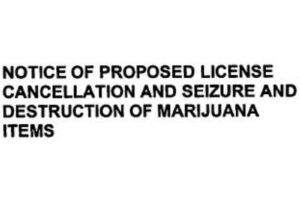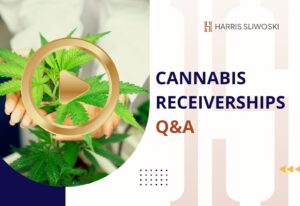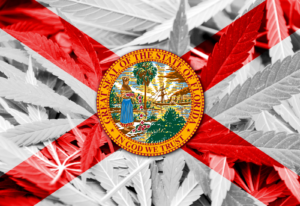Welcome to the sixth annual “State of the State” post on Oregon cannabis. This year was relatively staid compared to 2020, but key features included: a plateau in pricing and regulated sales; intensifying local competition; important new laws, administrative rules and policies; a hollowed out hemp market; and some interesting large company activity.
Sales look good, but dig a little
Backed by strong pandemic tailwinds, Oregon rocketed past the $1 billion sales mark in 2020. In 2021, the state will exceed that number again thanks to a big start. Lately, though, things have slowed appreciably, with a year-over-year decrease logged in every month since June.
Prices dropped throughout the fall as is typical after harvest. Today, the retail market is saturated with $3 grams of flower and $5 edibles. Wholesale flower is running at $900/lb. today versus $1200/lb. a year ago (and $1300/lb. in July of this year). It’s not as bad as the slaughter of 2018, but it’s hard to imagine the $1800/lb. prices of yesteryear ever coming back.
For anyone interested in doing a deeper dive on some of these trends, the OLCC keeps some good “Marijuana Market Data” sets here. What you won’t find in those sets are retailer reports that margins are better than ever. Several of our clients have reported margin increases of 5-10% over the past year or two. The unfortunate corollary, of course, is producers are suffering. Oregon marijuana producers are forever suffering. Craft cannabis growers in particular seem to have lost ground relative to low-cost growers, during COVID.
The environment remains competitive
At this time last year, Oregon had 719 licensed cannabis retailers. Today, there are 760, for a 5.4% increase. The number of producers increased 1,177 from to 1,388. That is an 18% increase— which wasn’t needed at all. Oregon also has 305 licensed processors and 21 licensed testing labs (sorry; I don’t have numbers on these classes from last year). A grand total of 1 licensed researcher exists— we work with them and it’s a funny story.
The ongoing uptick in licensees can be attributed to a couple of factors. The first is just how easy it is – and has always been – to acquire an Oregon cannabis license. Annual fees hover around $5K (plus another $5K in Portland), applications are rudimentary, and residency requirements do not exist. The OLCC also did a nice job refining its streamlined licensing program this year, in spite of staffing issues. Finally, the Commission announced last month that it will resume processing new license applications for everyone but producers– following a very pregnant “pause” exceeding three years.
As to producers, the SB 2018 moratorium on new license applications sunsets in a few days, on January 2, 2022. This means OLCC will once again have to accept these applications. Whether or not the Commission processes them timely is an open question. Another big question is whether the Oregon legislature will instate another moratorium on producer applications in the short session commencing on February 1. The smart money says that it will.
The bottom line is things are somewhat in flux, as always, and somewhat challenging, as always. A difficult labor market doesn’t help. Finally, with no bona fide export opportunities on the horizon – despite some noteworthy efforts – you can bet 2022 will be a grind too.
We expect to continue to help buy and sell a large number of Oregon cannabis businesses again in 2022. We’ll also support our longstanding clients on compliance, transactional and litigation matters, and wait as always for federal progress. And that’s about it.
New laws, rules and enforcement activity
Every year, I write a preview of the Oregon legislative session, and a summary at the end. You can expect the 2022 preview next month, and you can read the 2021 summary here. Rather than rehash what happened in the 2021 session, and in the interests of space, I want to focus on a few key developments. Both of these stem from the omnibus hemp bill known as HB 3000 (and to some extent SB 808).
1. Operation Table Rock
While the ink was still wet on Governor Brown’s HB 3000 signature, the OLCC launched Operation Table Rock in coordination with the Oregon Department of Agriculture (ODA). The agencies visited 316 registered hemp grow sites in Jackson and Josephine Counties, testing for undercover marijuana. The Commission’s summary of that effort is here. In short, 110 operators were found to be illegally growing high-THC marijuana, whereas 102 operators came back with acceptable test results. A total of 76 farms denied access to their properties (bad idea), and inspectors were unable to contact an additional 23 locations.
Ultimately, industry watchers weren’t surprised that 58% of the samples taken in this effort tested positive for unlawful levels of THC. Much of that product was likely intended for interstate sale; people have long since migrated from the medical marijuana program to hemp for that purpose. That said, smarter people than me took issue with the accuracy of LightLab portable machine tests used in these visits. Concerns over administrative law issues were raised as well, although we don’t have any of that litigation here in the office.
The Table Rock inspections also uncovered illegal water diversion from rivers and creeks (during a drought) and exploitation of immigrant laborers. In related news, the Oregon legislature met on December 13 in a one-day special session and dedicated an additional $25 million to help police, sheriff’s offices and community organizations crack down on unlawful marijuana grows (SB 893). It won’t be enough.
2. OLCC Rulemaking
The second noteworthy development stemming from HB 3000 has been OLCC administrative rulemaking. This Wednesday, December 28, the agency finalized major rule changes on a wide array of issues. These changes cover artificially derived cannabinoids, packaging and labeling, concentration limits, retailer delivery and quite a bit more. This rulemaking deserves a blog post of its own. For now, please check out the comprehensive OLCC bulletin here.
Hemp is stuck
Participation in the ODA hemp market has dropped precipitously. Most of our work in hemp is litigation, nowadays, and even that is slowing down.
As far as market data, ODA does a poor job of publishing compared to OLCC. From what I can find, though, estimated outdoor planted acreage decreased from 27,434 planted acres in 2020, to just 3,800 in 2021. Registered growers roughly halved, from 1,449 to 780. One inference to draw could be fewer Oregon hemp farmers planting more acreage. Elsewhere, the State of Florida issued an unintentionally funny warning about Oregon hemp containing rocks and sticks.
So what’s the real problem? People tend to blame FDA for stifling the industry’s growth. That is certainly part of the issue, but states have also cracked down heavily in the last couple of years on delta-8 THC and ingestible and smokable hemp products. Most of all, hemp needs to broadly infiltrate commodities markets, from textiles to building materials. Until that happens, Oregon will lag along with all the other states.
Big names in the news
- Dutchie, the cannabis Ecommerce platform out of Bend, raised a very impressive $350 million in a closed Series D. That company now boasts a $3.75 billion value… an Oregon cannabis unicorn!
- Curaleaf got sued up and down (nine times, so far) for shipping a THC product in CBD packaging. A tenth lawsuit alleging wrongful death is on the way. Earlier this year, its subsidiary Cura paid $500K to settle its class-action lawsuit related to vape cartridges.
- TerraTech Corp showed up to purchase Unrivaled, which has a significant Oregon presence mostly through LTRMN.
- GoldenLeaf came back from the dead to acquire five Home Grown Oregon stores.
________
For previous posts in this series, check out the following:
























